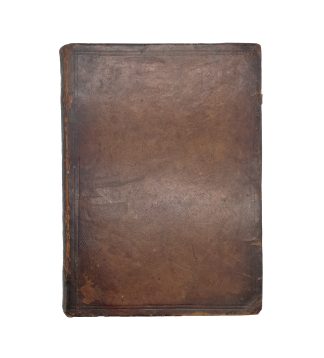PAGITT, Ephraim.
RARE FOLD OUT WORLD MAP
Christianographie, or the Description of the multitude and sundry sorts of Christians in the World not subject to the Pope.
London, Matthew Costerden, 1635£2,250.00
FIRST EDITION. 4to. Pp. (xxii) 156 56 (viii). Roman letter, some Italic, a little Greek and Hebrew. Ornamental head pieces and initials. Large woodcut fold out map of the world excluding America, three of Asia, Africa and Europe, Africa tear repaired without loss. Ms shelf mark to pastedown. Slight age browning, edges a little dusty, two oil spots to lower margin of first few leaves, finger soiling to tp and lower outer corner of early ll, ms correction to p. 21 ‘Germany’, a few red ink stains to upper edges, fly almost loose. A handsome copy with all maps, in contemporary sheep, ornamental spine gilt, restored at tail, rubbing to joints, some scratches to boards.
First edition of this curious book describing the Christian peoples that are “not subject to the Pope”. Ephraim Pagitt (c. 1575-1647) was an English clergyman and heresiographer, son of the controversial nonconformist clergyman Eusebius Pagit (c.1551-1617). Pagitt was a polyglot prodigy, who became known for his multi-linguistic talents when he was a child. It was these that led him to study other cultures and languages intensely, developing a passion for foreign lands and peoples. Eventually Pagitt compiled enough information to publish this Christianographie, which describes ethnic groups from Egypt and Persia to Korea and the Philippines. The publication was also intended to question the supremacy of the Pope and Catholicism, favouring a more balanced perspective of the different branches of Christianity. This kind of anti-Catholic dogma was increasingly common during this era, which Pagitt himself affirms in the book’s dedication to Francis White, Bishop of Ely (c. 1564-1638). White himself was a controversialist, who published and spoke prolifically against the omnipotence of the Catholic church.
Along with his other work, Heresiography, this publication was “devoted to describing and defeating the threat of irreligion which both popery and radical Protestantism posed” (Dyton, S.C. ‘Fabricating Radicalism: Ephraim Pagitt and seventeenth-century heresiology’, 2002). The work paints the author as an ‘explorer’, using various sources including anecdotes and historiographies in order to construct a picture of the Christian world beyond the Catholic church. The remarkable fold out map of the known world provides a fascinating insight into the intercontinental spread of Christianity by the early 17th century. Paggitt describes numerous regions of Africa and Asia and their relative concentrations of Christians. From a cartographic perspective, the map is relatively accurate, apart from Korea is shown as an island and Japan is somewhat misshapen. At the time of publication, most of the known world was under Roman Catholic influence. The 1494 Treaty of Tordesillas had divided the world into the Western Catholic Spain and the Eastern Catholic Portugal. The Americas were being Christianised, as was the Far East. Pagitt speaks of the Americas and how the native population was widely exterminated or forced into slavery, stating that “I may call their (the native Americans) first conversion (by the Spanish) rather a depopulation than a conversion”.
In stock











